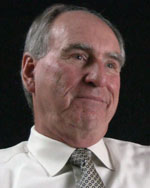Summary
Many newspapers are struggling with this problem: How does a newspaper with a reduced staff balance the time and resources needed for watchdog reporting with the growing expectation of readers to receive breaking news on multiple platforms? (Also see the report on The Columbia Missourian, and its experiment to separate its staff into digital and print coverage assignments, rather than having all reporters do both.)
The Wisconsin State Journal in Madison, Wis., considers its watchdog role in the state’s capital to be a coverage priority. Bill Johnston, the publisher; John Smalley, the editor; and Tim Kelley, the digital media manager, all stress that “keeping an eye on government” is a key contribution The Journal makes to its community and its state. Smalley gives an example of how The Journal uncovered the fact some legislators were campaigning on “work time.” That story led to statewide policy changes and the loss of some legislators’ jobs.
But multiple goals create split obligations. The Journal is also ramping up to be “an information provider with two platforms: print and digital, providing value-added content on each platform.”
Smalley describes life as a reporter now as: “covering a story, e-mailing a two-graph update, capturing video, posting to Twitter and Facebook, then coming back to write a longer story for print.” And, “You don’t do watchdog journalism necessarily on Twitter,” says Smalley. “[Watchdog reporting] takes time, effort and energy.”
Check This
Publisher, Bill Johnston, tells why he thinks the term “newspaper” is still a strong brand. The editor, John Smalley describes why he thinks there is still a lot of “mojo” in print. And the digital media manager, Tim Kelley, explains why project management skills are key for a new media manager in a rapidly shifting digital landscape.














